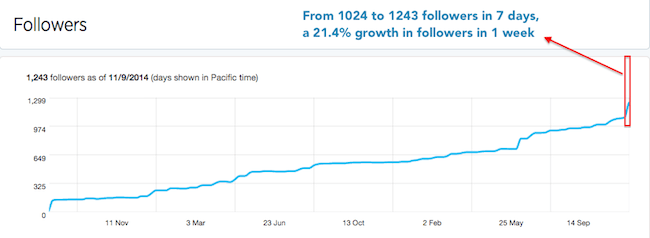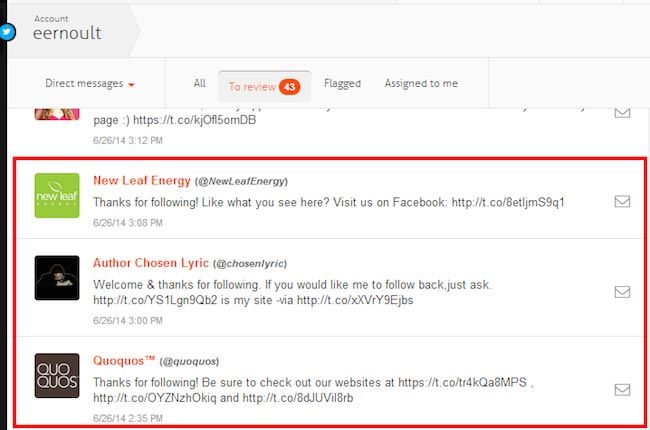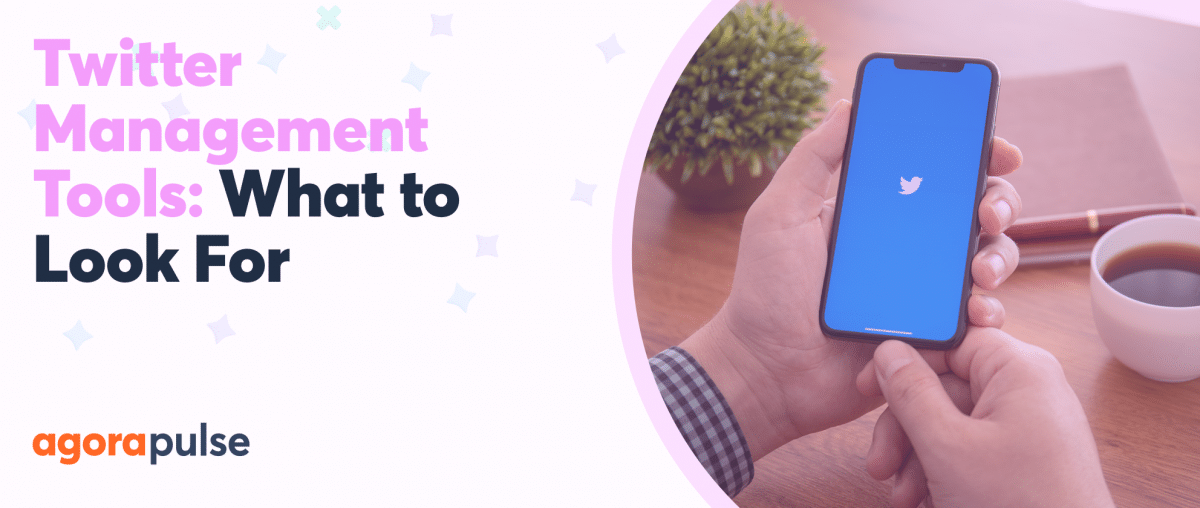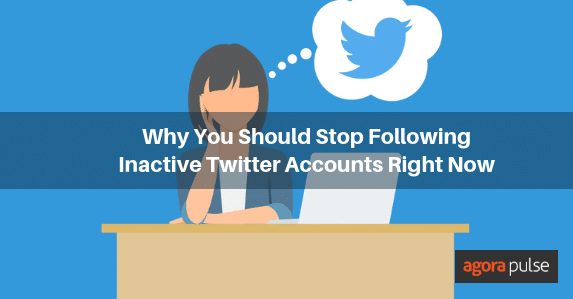Emeric and I compiled this list of 9 mistakes we often see businesses make on Twitter. Some of them have been repeated like a broken record, but we still see businesses make these mistakes over and over again. I find it hardly surprising when businesses claim that “Twitter doesn’t work.”
With the Agorapulse Inbox and Monitoring features, you won’t claim it anymore!
Whether you work in a social media team in a medium-sized business or an agency, you should probably write these 10 red flags into your rulebook for Twitter. To help you do that, we’ve broken these top mistakes into 3 categories:
-
o
- Automation
- Twitter bios
- Twitter followers and follows
o
o
And at the end of each top mistake we listed, I’ll share with you my suggestions.
Automation
1. Auto-thank all your new followers, whether it is a public tweet or direct message
Suggestion
My suggestion is simple and not too time-consuming. I have a daily routine where I spend 5 minutes to go through my list of new followers. I spend a few seconds reading the bio of each new follower before I tweet to them. If an account is obviously spam, I ignore it. If an account does not offer enough bio, I give a general reply but I’ll quote their name whenever possible. When the account is a business account like an agency, I’ll use the generic term “guys” to address them. I have seen the number of replies I receive increase by more than 100% just by addressing them by name.
2. Send a direct message your new followers unless you’ve followed them.
When you send a direct message to a follower, they cannot reply you unless you follow them too. This is an amateurish mistake we’ve found Twitter account managers commit when they do things without giving them enough thought.
Suggestion
If a user’s bio or tweets interest you, follow back before you drop them a direct message. But wait, have you asked yourself why you want to drop them a direct message? I’d do so only if I’m sure they have a need that I can help with.
3. Auto promote any of your stuff unless you’re sure it’s valuable to them.

Ever received one of these auto-promotional direct messages on Twitter?
When users follow you, it does not mean that they already endorse or trust you. They probably just felt interested enough to want to hear more from you.
That is why I can never understand why businesses automate the process of sending direct messages to all their new followers to promote their new product.
Even if you weren’t promoting your product but something that is supposed to help your target audience like the screenshot above, we all know that this is a lead generation tool and users are smart enough not to fall for it. So your automation tactics do not work and in fact, might work against you if you annoy your new followers.
Suggestion
Instead of auto-promoting your stuff, see how you can connect with each new user. For example, check out their tweets to see if they have any needs you can provide a quick solution to. If they don’t tweet, perhaps reach out to ask if they need help with anything that is relevant to your business.
Twitter Bios
4. Blabbering
Perhaps one of the most amateurish mistakes made by businesses on Twitter is to use a whole bunch of jargons that mean nothing to the users, or to go on and on and not getting to the point. It is a fundamental mistake that is easy to fix.
Suggestion
If you’re worried about style, do a quick search on Twitter and you’ll find more than a thousand ways of writing a good and relevant bio. But why should your bio deviate greatly from your elevator pitch?
Anyway, here is an example of an average bio that does the job:
5. Focusing on your goals (rather than helping your customers achieve theirs)
This is pretty self-explanatory. If all your Twitter bio does it to talk about yourself and not about your target audience, then no one is going to pay attention to you.
[Tweet “Nobody is going to pay attention to you if all you talk about is yourself. (Twitter for business mistakes!)”]
Suggestion
Fortunately, fixing this is simple. You just have to explain how your customers, followers, or audience benefit from your business, product, or tweets.

Tell others what you need/are looking for E.g. looking for a job in Denver so that businesses in Denver looking for people like you can reach out to you
6. Lack of a bio
I’ve come across another kind of bio that says nothing, quite literally. Unless you’re Taylor Swift or running a business like Apple, frankly nobody knows or remembers who you are. So the suggestion is simple, please write something.
Suggestion
Write something easy-to-read, something to the point, and something that tells people who you are and what you do. It can’t get any simpler.
7. Spamming hashtags
This is even more straightforward. Just cut down to the 1-3 most relevant hashtags if you must include one and share more about how your followers can benefit instead.
Follows/Followers
8. Obsess over your followers’ count.

Over 21.4% growth in followers within a week
So I experienced a rather explosive growth in the number of followers on Twitter last week.
It was due to a combination of 3 things that happened within a short span of time:
-
o
- I wrote a thorough user review for Agorapulse which garnered some good attention, a tool that serves some 70,000 Facebook pages
- I published my first article for Postplanner, one of the Facebook marketing blogs with the largest readership
- I was listed on Postplanner among 125 people to follow
o
o
Sure, I felt good knowing that someone out there actually cares enough to follow me. But how valuable are these followers?
One thing for sure, the sheer number of followers you have doesn’t actually help to pay bills in most cases.
It might help to attract advertisers if that is your business model.
For me however, of the approximately 200 new followers I gained, only 10 made it to my Twitter list of target audiences.
10 of them doesn’t sound like a poor number if all of them prove to be valuable in the end, but it is only 5% of the total number of new followers I gained. The remaining 95% of them include consultants, marketing professionals working in agencies, medium enterprise owners, and fake accounts.
And some naysayers might claim that a high follower count provides social proof for your brand. I don’t deny that it helps but this argument has been way overrated and is an underlying reason why many businesses fail to capture value on Twitter despite establishing their presence for months and even years.
So what would be a better suggestion?
Suggestion
Overcome the hype of getting new followers, read their bio, click on their website link if it doesn’t look spammy, and determine if they are relevant to your business. If they are, add them to a Twitter list and regularly interact with them or look out for their tweets in case they might talk about something you can help them with.
9. Follow someone just because he or she has a huge followers’ count.
I have a question for you – which of these two people would you follow if you were using Twitter for business?
Of course, the real answer is that it depends on what kind of business you are operating. But beyond such an obvious response, how should you decide if you should follow someone?
I try to keep it simple for myself because Twitter is considered a secondary focus for me. But since I have generated and converted valuable leads using Twitter, I’d like to share this with you:
Suggestion
First, I am pretty strict about who I follow. I only follow 2 groups of people:
-
o
- Thought leaders in specific niches, like inbound marketing, growth hacking, social media, search engine optimisation, etc.
- People who respond after I reach out to them, or who share my content regularly, so that I know for sure that these are my engaged community members. I discover them either through
-
o
- My new list of followers, filtered using the techniques I shared earlier
- Searching for specific keywords that describe the pain points I can help potential leads with
o
o
Conclusion
That’s it! Did you go through all 9 of them? Have you eliminated all 9 of these poor practices from your Twitter account management habits? If you know of even more common mistakes, we’d love to hear you share them with everyone in the comments below.












